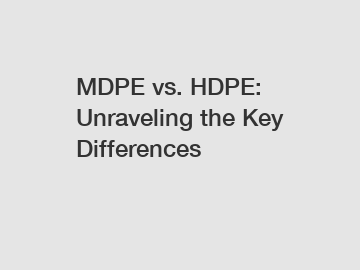Jan. 22, 2024
Rubber & Plastics
When it comes to choosing the right type of plastic pipe for your application, understanding the differences between various materials is crucial. Two popular options that often confuse people are MDPE (Medium Density Polyethylene) and HDPE (High Density Polyethylene). In this blog post, we aim to demystify the disparities between these two types of pipes to help you make an informed decision for your specific needs.
Understanding the Basics:
Polyethylene, a thermoplastic polymer, is widely used in various industries due to its versatility, durability, and resistance to chemicals. Both MDPE and HDPE are derived from polyethylene, but different manufacturing processes result in varying physical and chemical properties, making them suitable for different applications.

Density Matters:
One of the primary distinctions between MDPE and HDPE lies in their density. HDPE has a higher density that makes it stronger and more rigid compared to MDPE, which has a lower density. Due to its superior strength, HDPE pipes are commonly used in industrial and infrastructure projects that require resistance to significant pressure and external forces.
MDPE – Flexibility and Versatility:
MDPE, with its lower density, offers a more flexible and versatile option. It possesses enhanced elasticity, making it ideal for applications that require pipes to withstand stress caused by ground movement or temperature fluctuations. Water supply, irrigation, and domestic gas distribution are among the popular areas where MDPE pipes excel.
Pressure Ratings:
The pressure rating of the pipe is of utmost importance, as it determines its capability to handle diverse applications. HDPE pipes have higher pressure ratings and can withstand more demanding conditions. This attribute makes HDPE an excellent choice for heavily pressurized systems, such as water mains and industrial pipelines.
MDPE, although not as robust as HDPE, has sufficient pressure ratings for many common applications. It can reliably handle garden irrigation systems, drainage systems, and moderately pressurized gas distribution networks.
Chemical Resistance:
Another vital characteristic to consider is the chemical resistance of the chosen pipe material. Both MDPE and HDPE exhibit excellent resistance to a wide range of chemicals, including alkalis, organic solvents, and acids. However, HDPE offers superior chemical resistance, making it an ideal option for applications that involve aggressive chemicals or environments, such as chemical labs and waste management facilities.
Joining Methods:
The joining method plays a crucial role in the installation process, affecting the overall effectiveness and longevity of the system. HDPE pipes are typically joined using heat fusion techniques like butt-welding or electrofusion. This fusion process creates a strong and leak-proof joint, delivering exceptional durability.
On the other hand, MDPE pipes are commonly joined through mechanical fittings like compression fittings or push-fit connectors. These fittings provide a reliable connection, allowing for quick and easy installations that require minimal expertise, making MDPE an excellent choice for small-scale domestic projects.
Environmental Impact:
In today's world, the environmental impact of any product must be considered. Both MDPE and HDPE pipes are environmentally friendly choices due to their recyclability and non-toxic nature. However, HDPE has an advantage when it comes to impact on the environment, as it requires less energy to produce and has a longer lifespan, resulting in a smaller carbon footprint.
In Conclusion:
While MDPE and HDPE share similarities due to their polyethylene base, they have distinct characteristics that address different application requirements. HDPE offers superior strength, high pressure ratings, and better chemical resistance, making it ideal for industrial and infrastructure projects. MDPE's flexibility, versatility, and ease of installation, however, make it well-suited for smaller-scale applications.
Ultimately, the choice between MDPE and HDPE pipes will depend on factors such as pressure requirements, installation preferences, desired lifespan, and budget. By understanding the key differences outlined in this blog post, you can confidently select the most appropriate polymer pipe for your specific needs. Remember, consulting with experts in the field can further ensure a successful outcome for your project.
For more information, please visit HDPE Dredging Pipes, hdpe water pipes, mdpe properties.
If you are interested in sending in a Guest Blogger Submission,welcome to write for us!
All Comments ( 0 )